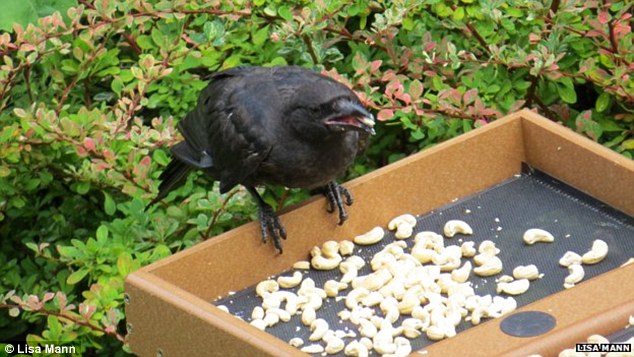In a quiet Seattle neighborhood, a story began around 2011 that seems more like a modern fairytale or a script from a fantasy film. But it is entirely true, documented, and it serves as one of the most powerful, real-world examples of the astonishing power of crow intelligence. What started as a four-year-old girl’s simple, kind act of sharing her lunch, blossomed into one of the most studied and heartwarming interspecies friendships ever recorded. It is a relationship built on trust, routine, and a startling system of reciprocity that has captured the imagination of the world.
This story is not about a scientist or an animal trainer. It is about Gabi Mann, a little girl who, with no agenda, simply wanted to share.

The First Offering
Like many children, Gabi was a messy eater. On walks with her mother or after school, she would drop food. The neighborhood crows, always watching, would swoop down to snatch up the leftovers. For Gabi, it was a moment of delight. She loved their fluttering, their cautious steps, and the way they cocked their heads.
It was pure, innocent generosity. She wasn’t conducting an experiment; she was just being kind. She began to donate bits of her snacks on purpose, scattering peanuts and bits of bread with her tiny hands. She saw herself as the observer, but she couldn’t have known that she, too, was being intensely studied.
The Watchers
Crows are often misunderstood. We see them as noisy scavengers, symbols of bad omens. Yet, behind their dark feathers lies one of nature’s most brilliant minds. Scientists who dedicate their careers to studying crow intelligence consistently place their cognitive abilities on par with chimpanzees and even young human children.
They are known to use tools to solve complex, multi-step puzzles. They have sophisticated social structures and have been observed holding “funerals” for their dead. Most importantly, they are one of the few non-human species proven to recognize and remember individual human faces for years, passing that information on to their flock and even their offspring. They remember who is kind and who is a threat.
And in Gabi, they saw a friend.
Day after day, they watched her. They noted her consistency and her gentleness. Slowly, they began to trust. Their swoops became bolder. They would linger on fences and rooftops, waiting for her. Soon, they were not just birds visiting a yard; they were companions waiting for a friend.
Gabi, in her innocence, embraced them as such. Her routine became more deliberate. She and her family began filling birdbaths and setting out bowls of peanuts and dog kibble at the same time each day. She spoke to them, unbothered that they couldn’t answer in words. Their presence was answer enough.
Gifts from the Sky
Then, the relationship changed. The crows decided to give something back.
It began with small, curious objects appearing near the feeding dish. A single bead. A piece of polished sea glass. A bent screw. A rusted keychain. At first, Gabi’s family assumed it was just random debris, garbage left by the wind.
But the pattern became unmistakable. With increasing regularity, shiny, interesting trinkets appeared in the exact spot where the food had been placed. They were left there deliberately.
The crows were paying for their meals.
Gabi treated these gifts with a reverence that was, in itself, beautiful. While others might see a bottle cap or a fragment of glass as trash, she saw treasure. Each one was carefully placed in a labeled box, cherished as proof of a secret language—a language that spoke not in words, but in action: We see you. We remember. We thank you.
Over time, that box filled with dozens of tokens. A small, heart-shaped charm. A tiny piece of a credit card. A button. A Lego. A bit of metal. Each item was a deliberate choice, a symbol of a connection that defied all of our normal rules.
The Ultimate Test of Trust
Then came the moment that sealed the truth of their bond, removing any last shadow of a doubt.
One day, Gabi’s mother, Lisa, was working in the garden and dropped the lens cap from her camera. It was a small, black object, lost in the bushes and dirt. Despite searching carefully, the family couldn’t find it. Days passed, and the cap was given up for lost.
Until one afternoon, it reappeared.
The missing lens cap was sitting neatly on the edge of the birdbath. A crow had found it, recognized it as belonging to the family, and returned it. This was not a random trinket. This was a returned possession. This was the recovery of a lost and valued item. It was an act of service, a sign that the crows understood enough of Gabi’s world to recognize what belonged to her—and to give it back.
The Deeper Meaning
This story is about more than just crow intelligence. It is about the simplicity of a bond formed out of pure kindness. A child gave food. The birds gave back what they could. In that simple, daily exchange, a relationship was built that was stronger than many human friendships—a relationship built on trust, gratitude, and mutual recognition.
Gabi’s story challenges how we see the world. It teaches one of the most important life classes of all: that no act of kindness, no matter how small, is ever wasted. Gabi’s handfuls of peanuts were not extraordinary on their own. But when repeated with consistency and genuine care, they became a bridge. They spanned the gap between human and animal, between fear and trust, and between indifference and gratitude.
Years later, people all over theworld still talk about the girl who befriended crows. Scientists have studied the behavior, using Gabi’s experience as further evidence of the complex, emotional lives of corvids. But for those of us who hear the story, the message is much simpler and far more personal:
Kindness is noticed. Kindness is remembered. And kindness will be returned, often in ways we can never predict.
Gabi’s gifts are not valuable in terms of money, but they are priceless in meaning. Each one is a reminder of her bond, a symbol of the truth she discovered as a child: that even the smallest, most selfless acts can create ripples that reach further than we ever imagine. In the end, the story of Gabi Mann is not just about crows or gifts. It is about us. It is about the choices we make every day to notice, to give, and to connect.


